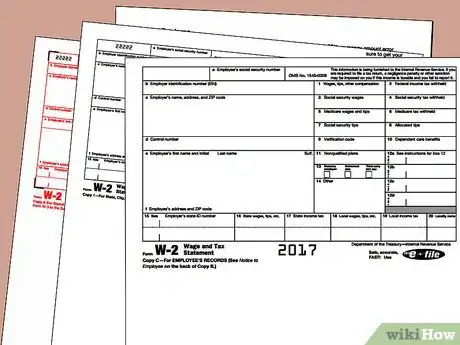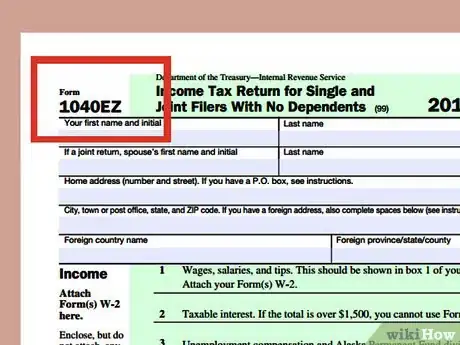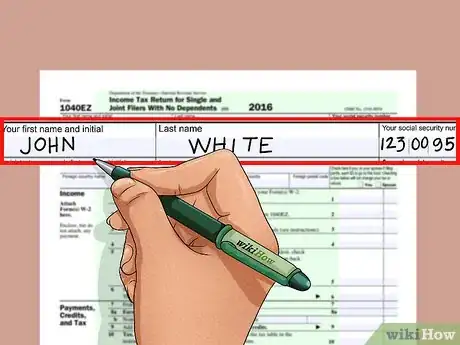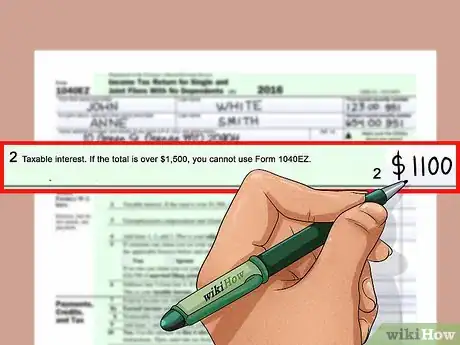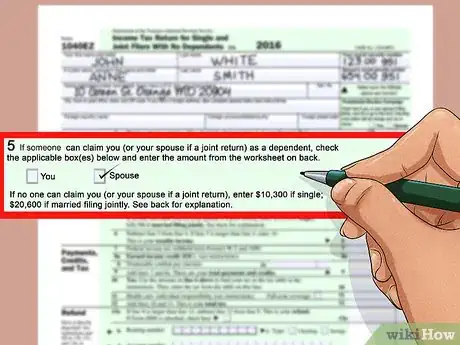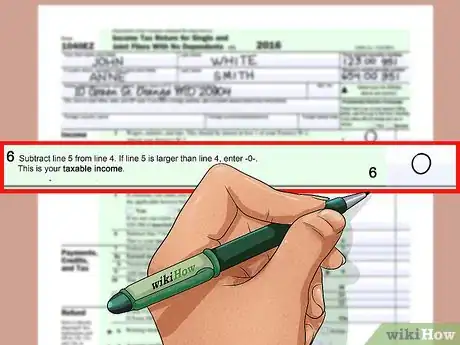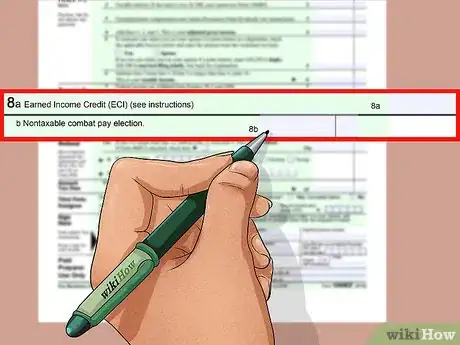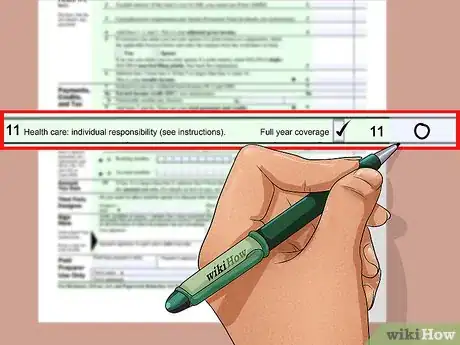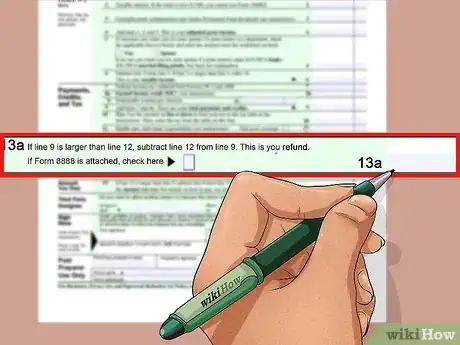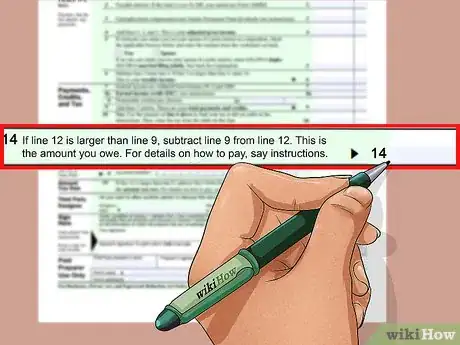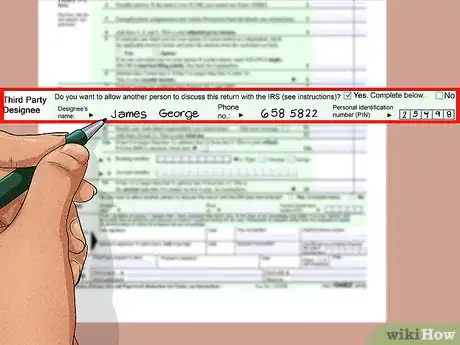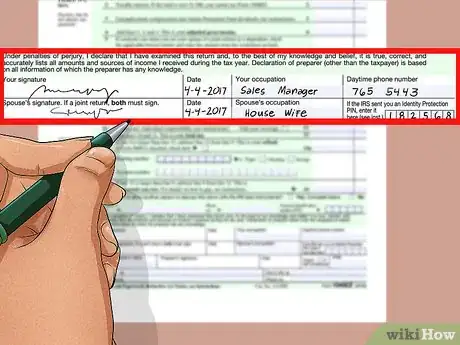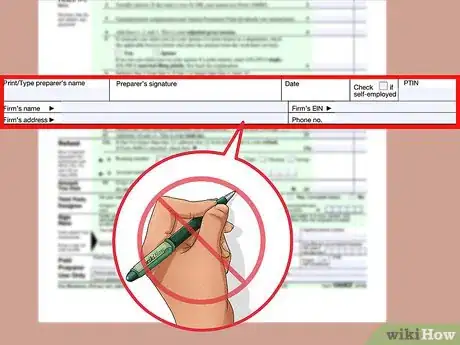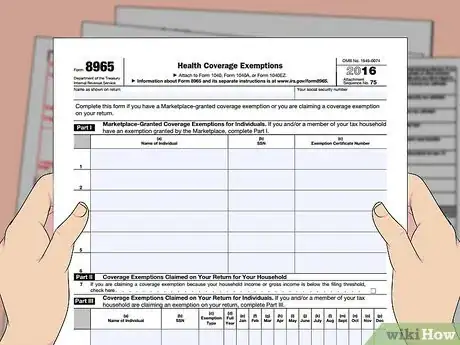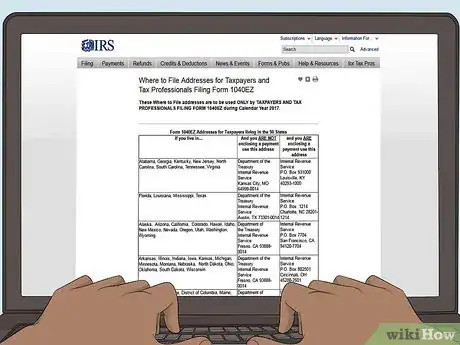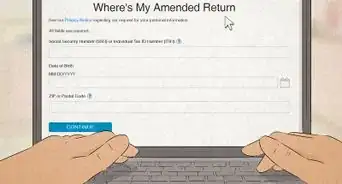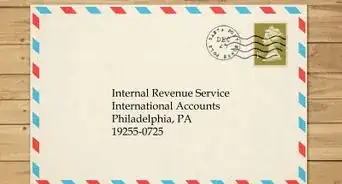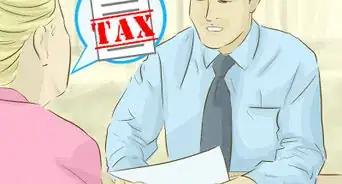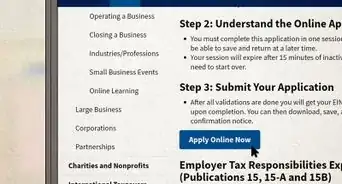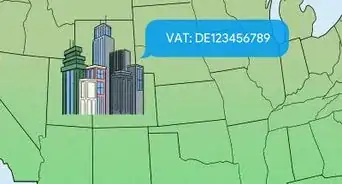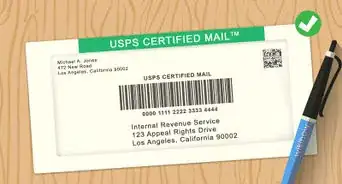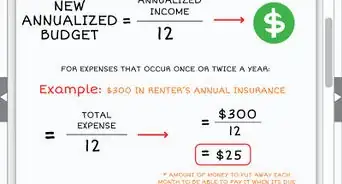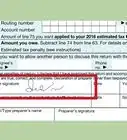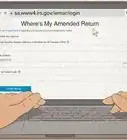This article was co-authored by Michael R. Lewis. Michael R. Lewis is a retired corporate executive, entrepreneur, and investment advisor in Texas. He has over 40 years of experience in business and finance, including as a Vice President for Blue Cross Blue Shield of Texas. He has a BBA in Industrial Management from the University of Texas at Austin.
There are 10 references cited in this article, which can be found at the bottom of the page.
wikiHow marks an article as reader-approved once it receives enough positive feedback. This article has 11 testimonials from our readers, earning it our reader-approved status.
This article has been viewed 331,711 times.
Every April, that dreaded day comes along when American wage earners have to file their federal income taxes. Until recently, the 1040EZ was the easiest federal return form to use. While the 1040EZ is no longer available for tax years starting from 2018 on, you can still use it if you need to file back taxes or amend your returns from previous years (2017 and earlier). Some restrictions on its use do exist, and some of the form's lines can be a bit confusing. Overall, though, the process of filling out a 1040EZ form is relatively simple. If you’re filing taxes for 2018 or later, you’ll need to use Form 1040.
Steps
Determining if You Can Use the Form 1040EZ and Gathering Materials
-
1Determine if you are eligible to use form 1040EZ. You can file the 1040EZ only if your filing status is single or married filing jointly, both taxpayers are under 65 and not blind, and you do not claim any dependents other than yourselves.
- Your total taxable income must be less than $100,000, and it must all be derived from wages, salaries, tips reported on your W-2 (usually not unreported tips), taxable scholarship or fellowship grants, unemployment compensation, Alaska Permanent Fund dividends, and/or taxable interest of $1,500 or less.
- The only tax credits you can claim on the 1040EZ are the Earned Income Credit and the Making Work Pay tax credit.[1] [2]
- If you fall outside of this description, you will need to file either the 1040 or the 1040A.
-
2Gather your W-2 forms. If you are employed, or have been at any point in the year, you'll need the W-2 sent by your employer. If you worked for several different employers over the course of the year, be sure that you go a W-2 from each employer. The forms should arrive before February 15.
- If you are filing after February 15 and you still don't have your W-2 Wage and Tax Statement, call the Internal Revenue Service (IRS) and provide your name, full address, SSN, dates of employment, and your employer's name, full address, and phone. If you don't receive the W-2 within a reasonable period of time, file a substitute W-2. You can print off a blank W-2 at http://www.irs.gov/app/picklist/list/formsInstructions.html. Make sure you have figured the tax withheld, day for day, until December 31.
- If you have any forms used to report income other than W-2s, you'll need to use form 1040 instead.
Advertisement -
3Obtain the 1040EZ form for the current tax year at http://www.irs.gov/pub/irs-pdf/f1040ez.pdf. You can also get a copy at a local library or post office.
- If you need a form for a prior tax year, you can search for it at http://www.irs.gov/Forms-&-Pubs.
Completing the Top Section
-
1Fill in the primary taxpayer’s full name and Social Security number on the top line. This should be your full, legal name, as matched to the records of both the Social Security Administration and IRS taxpayer records.
- If you are married filing jointly, it does not matter which name goes on top, so long as you file the same way each year.
- If you received a printed packet and the peel-off label is accurate, you can just peel off the label and stick it over this portion. If you are downloading the form or do not have a label, you will fill this out by hand.
-
2Fill in your spouse’s full, legal name and Social Security number, as matched to the records of both the Social Security Administration and IRS taxpayer records, on the second line. If you are single, leave the second line blank.
- Adding your spouse means you are filing "married filing jointly." Only your name means you are filing single. You cannot file "married filing separately," "head of household" or "qualifying widow(er)" with the 1040EZ form.
-
3Put your home street address on the third and fourth lines. If you have a PO box address and a street address, use the street address. You should only use a PO box address if your post office will not deliver mail to your home.
- If you live in a foreign country, fill in the information on the 5th line. If you live in the United States, leave that information blank.
-
4Check the "presidential election campaign" box (in the shaded area) if you like. If you check the box, $3 of the taxes you paid will be put in a special fund and distributed to serious presidential candidates who agree to limit campaign spending and refuse private donations. You will pay the same amount in taxes either way.
- Checking this box does not increase your tax nor decrease your refund. The $3 is paid for by the government.
Completing the Income Section
-
1Enter your gross wages, salaries and tips. Look at your W-2 form(s) and find box 1. If you have more than one W-2 form, add the amounts in box 1 together and enter that amount in line 1 of the 1040EZ form.
- You should have received a W-2 from an employer. If you did not, contact that employer for a replacement.
- If you have no wages, salaries and/or tips, enter 0 (zero) on line 1.
-
2Enter your taxable interest on line 2, if you have any. Taxable interest is interest you receive from accounts you have with other people or institutions. For instance, if you have a bank account or investment account that pays you interest, that interest is usually taxable. If you loaned money to a friend and charged interest, that interest is taxable.
- You are required to report taxable interest regardless of whether you receive a 1099-INT, 1099-OID or any other tax document for that taxable interest. If you know you have taxable interest but are unsure of the amount, contact the institution that is paying that interest.
- If your total taxable interest is greater than $1,500, you can't use the form 1040EZ and must use either Form 1040 or 1040A. If your total taxable interest is $1,500 or less, enter that amount on line 2. If you have no taxable interest, enter 0 (zero) on line 2.
-
3Enter the amount you received in unemployment benefits on line 3 if you received any. If you did receive unemployment benefits, you should have received form 1099-G. If you did not receive that form, contact your local unemployment office for assistance including a replacement.
- If you are an Alaskan resident, you should have received form 1099-MISC for your Permanent Fund Dividend (PFD). If you did not, go to https://pfd.alaska.gov/Payments/TaxInformation to print a new one.
- Add the amounts from your unemployment and PFD, and enter the total on line 3. If you had neither of these forms of income, enter 0 (zero) on line 3.
-
4Add lines 1, 2 and 3 together. Enter the total on line 4. This is your Adjusted Gross Income.
-
5Enter your personal and standard deductions on line 5. If you are not claimed as a dependent, follow the instructions and write the dollar amount associated with your filing status (single or married filing jointly), as described on that line of the form.
- For 2014, the standard deduction for a single person was $10,150 and the deduction for a married couple filing jointly was $20,300.[3]
- If neither you nor your spouse (if applicable) can be claimed as a dependent on someone else’s tax return, enter the appropriate amount stated in the shaded area on line 5. The amounts are listed on the form.
- If you or your spouse can be claimed on someone else's taxes, complete the worksheet on the back of the form (if you received a pre-printed form) or on page 2 of the form (if you downloaded the form). This will tell you what to enter on line 5. If you or your spouse cannot be claimed by someone else, you do not have to fill out this form.
-
6Subtract line 5 from line 4 and enter that amount on line 6. If line 5 is larger than line 4, enter 0 (zero) on line 6. This is your taxable income.
- If the amount is more than $100,000, you can't use the 1040EZ and must file either form 1040 or 1040A.
Completing the Payments, Credits and Tax Section
-
1Look at your forms W-2, 1099-INT, 1099-G and 1099-OID. Find the box on each of these forms that is labeled "federal income tax withheld" from box 2. Add up all these amounts and enter the result in line 7.
- If you do not have any of these forms, enter 0 (zero).
-
2Figure out if you are eligible for the Earned Income Credit. The EIC benefits working people who have low to moderate incomes by lowering their tax burden. In order to qualify or the EIC, you need to make below a specified amount per year. In 2014, a single person with no children had to make below $14,590 to qualify.[4] If you are married and/or have children, the amount you earn can be higher.
- You will need the instructions to form 1040EZ to calculate this credit because the amounts change each year. You can find these instructions at http://www.irs.gov/Forms-&-Pubs.
- These instructions are very clear and easy to follow. Although the steps are similar and the outcome is the same, the worksheet is different than the EIC worksheet for forms 1040 and 1040A.
- After completing the worksheet, enter the amount of the credit on line 8a. If you want the IRS to calculate this credit for you, enter “EIC” in the shaded space on line 8a and leave the unshaded space blank.
- If you are or were in the military and received nontaxable combat pay for the tax year, this is still earned income for Earned Income Credit purposes and will affect your eligibility and calculations. Enter the amount of nontaxable combat pay (from box 12 of your W-2) in line 8b.
-
3Add lines 7 and 8a to get "total payments and credits" and enter the result in line 9. If you requested an extension using Form 4868, you should add the amount you paid to the IRS with the extension (not counting any convenience or service fees you were charged based on your payment method) to the amounts on lines 7 and 8a and enter the total in line 9.
- If you did not request an extension, simply add lines 7 and 8a and enter the total in line 9.
-
4Locate the tax table close to the end of the instructions for form 1040EZ. Locate your income range, then follow that line of numbers to the right until you reach the number directly below your filing status. That number is your tax liability. Enter it on line 10.
- If you want the IRS to compute your tax for you, simply leave this line blank. For the IRS to calculate your tax, you must file by April 15 without any extensions; you can't have a refund directly deposited into a bank account; and you can't apply any part of your refund to the following year’s liability. Also, if you owe taxes, the IRS will send you a bill which must be paid either by April 15 or 30 days after the issue date of the bill, whichever is later.
-
5Assess whether if you had minimum essential health care during the tax year. This is a change for 2014 taxes, requiring that all Americans have health coverage. If you did not have health coverage, you either need to apply for an exemption or make an individual shared responsibility payment.[5]
- Check the box in the shaded portion of line 11 and either enter 0 in the unshaded portion or leave it blank if you and your spouse had minimum essential health care coverage for the entire year.
- Most health care coverage that people have is minimum essential coverage. Minimum essential coverage includes: health coverage provided by your employer; health insurance coverage you buy through a Health Insurance Marketplace; many types of government-sponsored health coverage, including Medicare, most Medicaid coverage and most health care coverage provided to veterans and active duty service members; and certain types of health care coverage you buy directly from an insurance company.
- If you and your spouse can both be claimed as a dependent on someone else’s tax return, skip line 11.
- If you or your spouse, if applicable, enrolled for health care coverage through a Health Insurance Marketplace and wish to claim the premium tax credit, you may not file Form 1040EZ and must file either the Form 1040 or 1040A instead.
- If you or your spouse did not have minimum essential health care coverage but believe you have an exemption, you will need to complete Form 8965. You can find Form 8965 and its instructions for the current year and prior years at http://www.irs.gov/Forms-&-Pubs. The long list of exemptions approved by Congress for that particular tax year can be found around page 2 of the instructions.
- If you or your spouse did not have minimum essential health care coverage and do not qualify for an exemption, complete the Shared Responsibility Payment Worksheet found beginning on approximately page 5 of the instructions for Form 8965. Enter your shared responsibility payment (the last number on the worksheet) on line 11 of Form 1040EZ.
-
6Add lines 10 and 11 together and enter the total on line 12. This is your total tax liability; in other words, the total amount of tax you need to pay.
Calculating Your Refund or the Amount You Owe
-
1Determine if you are due a refund. If line 12 is larger than line 9, leave this section blank because you are not due a refund. If line 9 is larger than line 12, subtract line 12 from line 9 and enter that amount in line 13a.
- If this amount is less than $1, you must send a letter requesting your refund.
- If you want this refund split between multiple bank accounts or used to purchase US Savings Bonds, check the box in the shaded portion of line 13a and complete Form 8888.
-
2Fill out direct deposit information if you want your refund directly deposited into a bank account. Complete lines 13b, c and d.
- Enter your bank’s routing number in the boxes for 13b. The routing number is the 9-digit number on the bottom left of your pre-printed deposit slip.
- Check in box 13c whether the account is a checking account or a savings account.
- Enter your account number in 13d. The account number will be the number to the right of your routing number on your deposit slip. The last digit of your account number should be written in the box farthest to the right in 13d. Any boxes remaining after entering all numbers can be left blank.
-
3Calculate the amount you owe. If you calculated that you are not due a refund, then you will likely owe taxes.
- If line 9 is larger than line 12, leave this section blank. You do not owe any additional taxes.
- If line 12 is larger than line 9, subtract line 9 from line 12 and enter it on line 14. This is the amount of additional taxes you owe.
- If you owe less than $1, you do not have to pay.
- You can pay this amount by attaching a personal check made payable to the U.S. Treasury (ensure your name, address, and Social Security number are on the check) or by any method included at http://www.irs.gov/Payments, including credit or debit card, automatic deduction from your bank account or other methods.
Finishing and Filing Your Return
-
1Complete the Third Party Designee section. If you want the IRS to contact someone other than you for any questions or comments about your return, check the box beside “Yes” in this section. Then write that person’s name and phone number (with area code) in the appropriate areas in this section.
- Select a 5-digit number that this person can use to identify themselves to any IRS representative who contacts them and enter it in the area for the Personal identification number (PIN). Be sure to let your third party designee know this number.
- If you do not want the IRS to discuss your return with someone other than you or your spouse, check the box beside “No” in this section.
-
2Sign your form. You and your spouse, if applicable, should both sign your names as they appear at the top and as they match the records for both the Social Security Administration and the IRS tax database. You should each date it the same date as you signed it. Each of you should list your occupations.
- By signing the form, you are swearing that the information on the form is true and correct to the best of your knowledge. You face criminal penalties for knowingly filing inaccurate information.
- A daytime telephone number (with area code) should be listed in the space provided.
- If you have been provided an identity protection PIN, enter it in the space provided. If you do not have an identity protection PIN, leave that space blank.
-
3Leave the paid preparer use only section blank. This section should only be used by professional tax preparers.
-
4Prepare supplementary materials to include with your return. Detach Copy B of all Forms W-2. If you prepared any additional forms, such as Form 8965 or 8888, gather them.
- If you owe and plan to pay by check, write your check.
-
5Make a copy of all of these documents and the Form 1040EZ for your files. You will need to keep a copy of your taxes for your records.
-
6File your tax return. Mail the originals of all documents to the IRS at the appropriate address listed on the last page of the instructions.
- You can file your return electronically through a variety of tax preparer websites.
Expert Q&A
-
QuestionHow do I complete page 2 of the 1040EZ?
 Michael R. LewisMichael R. Lewis is a retired corporate executive, entrepreneur, and investment advisor in Texas. He has over 40 years of experience in business and finance, including as a Vice President for Blue Cross Blue Shield of Texas. He has a BBA in Industrial Management from the University of Texas at Austin.
Michael R. LewisMichael R. Lewis is a retired corporate executive, entrepreneur, and investment advisor in Texas. He has over 40 years of experience in business and finance, including as a Vice President for Blue Cross Blue Shield of Texas. He has a BBA in Industrial Management from the University of Texas at Austin.
Business Advisor There is no required information on Page 2 of the 1040EZ. The worksheet on page 2 is a worksheet to help you determine the amount you can deduct if you or your spouse is a dependent of another taxpayer.
There is no required information on Page 2 of the 1040EZ. The worksheet on page 2 is a worksheet to help you determine the amount you can deduct if you or your spouse is a dependent of another taxpayer. -
QuestionWhere do you mail your 1040-EZ?
 Michael R. LewisMichael R. Lewis is a retired corporate executive, entrepreneur, and investment advisor in Texas. He has over 40 years of experience in business and finance, including as a Vice President for Blue Cross Blue Shield of Texas. He has a BBA in Industrial Management from the University of Texas at Austin.
Michael R. LewisMichael R. Lewis is a retired corporate executive, entrepreneur, and investment advisor in Texas. He has over 40 years of experience in business and finance, including as a Vice President for Blue Cross Blue Shield of Texas. He has a BBA in Industrial Management from the University of Texas at Austin.
Business Advisor If you e-file your return, there is no need to mail it. There a number of IRS addresses where your form should be mailed based upon your home address. See the last page of Instructions for completing Form 1040EZ for a list of the addresses, visit the IRS website, or call the IRS help line at 800-829-1040.
If you e-file your return, there is no need to mail it. There a number of IRS addresses where your form should be mailed based upon your home address. See the last page of Instructions for completing Form 1040EZ for a list of the addresses, visit the IRS website, or call the IRS help line at 800-829-1040.
Warnings
- This article is for informational purposes only. If you have any questions you should seek out a tax professional.⧼thumbs_response⧽
- This is not tax advice. Tax laws change from year to year. This article attempts to stay within the most common adjustments. It is intended to give you the information to do your taxes yourself. You should be able to do every kind of the most common individual taxes with the instructions and the Pub 17. However, if you run into questions that are just too confounding, don't hesitate to call the IRS help line.⧼thumbs_response⧽
- The IRS will pursue you if anything on your return appears to be fraudulent. If they bring an error to your attention, just correct it and follow it through. File a 1040X Amended form as soon as possible to correct the error. It's a correction process that's there to help you amend an error. The only thing you can really do wrong is to ignore it or run from it.⧼thumbs_response⧽
References
- ↑ https://turbotax.intuit.com/tax-tools/tax-tips/IRS-Tax-Forms/What-Is-the-IRS-1040EZ-Form-/INF14498.html
- ↑ http://www.irs.gov/uac/The-Making-Work-Pay-Tax-Credit
- ↑ http://www.irs.gov/pub/irs-prior/f1040ez--2014.pdf
- ↑ http://www.irs.gov/Credits-&-Deductions/Individuals/Earned-Income-Tax-Credit/EITC-Income-Limits-Maximum-Credit-Amounts
- ↑ http://www.irs.gov/Affordable-Care-Act/The-Individual-Shared-Responsibility-Payment-An-Overview
- ↑ https://apps.irs.gov/app/picklist/list/formsPublications.html
- ↑ http://www.irs.gov/app/picklist/list/formsInstructions.html
- ↑ http://www.irs.gov/app/picklist/list/formsInstructions.html?resultsPerPage=200&sortColumn=sortOrder&indexOfFirstRow=0&criteria=&value=&isDescending=false
- IRS Pub 17
- 1040EZ Instructions
About This Article
To fill out a US 1040EZ tax return, you must be under 65, not claiming dependents, and have income less than $100,000. If you qualify, obtain your W2 from your employer and use the information on it to fill out the tax return form. Then, follow the directions on the form to calculate your refund amount. Finally, sign your form and submit it by sending it to the appropriate address from the IRS.gov website. For help filling out each section of your 1040EZ form, keep reading!

